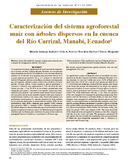| dc.description.abstract | Se caracterizó el sistema agroforestal de maíz con árboles dispersos en la Cuenca del Río Carrizal, Manabí, Ecuador, el cual presenta bajas densidades de árboles (11 árboles ha exponente -1), con una baja cobertura arbórea (3,5 por ciento del área de la parcela), baja área basal )0,6 m{ostrok} ha exponente -1) y pocas especies por parcela (6,5¦ 2,7). Aunque se encontró un total de 58 especies arbóreas en las fincas, el sistema está dominado por seis especies arbóreas nativas (Guazuma ulmifolia, Prosopis pallida, Prosopis affinis, Cordia alliodora, Albizia guachapele y Leucaena trichodes), que representan el 72 por ciento del total de individuos con dap mayor que 5 cm. El 62 por ciento de los árboles muestreados eran manejados por podas y desrames. Las especies usadas para leña, alimento para ganado y que poseen copas densas fueron manejadas con podas, mientras que aquellas especies útiles para madera o construcciones rurales, o con copas ralas, fueron desramadas. Los productores mencionaron 11 aspectos positivos de tener árboles en sus parcelas, incluyendo la producción de madera (68 por ciento de los productores), leña (60 por ciento), alimento para ganado (24 por ciento), sombra para personas (28 por ciento) y animales (23 por ciento). Además, señalaron que los árboles dispersos ofrecen limitantes para la producción de maíz porque compiten con este por agua y luz. Mencionaron 10 especies arbóreas que son buenas para combinar con maíz, de las cuales las principales fueron C. alliodora, A. guachapele y Prosopis spp. An agroforestry system of dispersed trees in corn fields was characterized in the Río Carrizal watershed, in Manabí, Ecuador. Low tree densities (11 trees ha exponente -1), little tree cover (3.5 percent of field area), small basal area (0.6 m{ostrok} ha exponente -1) and few tree species per field (6.5 ¦ 2.7) were observed. Although a total of 58 tree species were found in the farms, the system was dominated by six native tree species (Guazuma ulmifolia, Prosopis pallida, Prosopis affinis, Cordia alliodora, Albizia guachapele and Leucaena trichodes), which represented 72 percent of the individuals with dap major 5 cm. Sixty-two percent of the trees sampled were managed by pollarding and pruning. Tree species used for firewood or livestock fodder, or that have dense canopies, were managed by pollarding, whereas species used for timber or rural construction, or that had thin canopies, were managed by pruning. Farmers mentioned 11 positive aspects of having trees in their fields, including timber production (68 percent of the farmers), firewood production (60 percent), fodder for livestock (24 percent), and shade for people (28 percent) and animals (23 percent). The main drawback of the dispersed trees, recognized by farmers, is that they compete with the corn for water and light. The producers mentioned 10 tree species that are suitable for combining with corn production, of which the most frequently mentioned were C. alliodora, A. guachapele and Prosopis spp. | es_ES |



